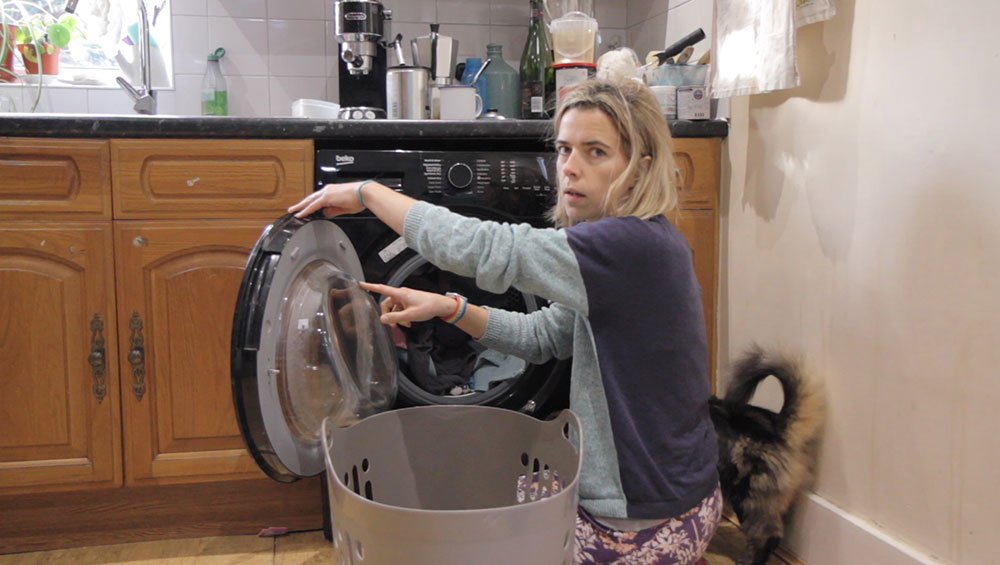
Lana Locke. Photo: © Toby Paton, 2020.
by CHRISTIANA SPENS
Journeys of a Laundry Mountain, a short film by Lana Locke, shot during 2020, is an autobiographical reflection on her responsibility as a woman and a mother for her family’s laundry, but becomes a vehicle for the consideration of wider, global issues through the crises that emerge during the film. Shot between gentrifying south-east London and rural Queensland, scenes of her own challenging domestic environment and that of her parents are intercut with provocative and humorous found and archive footage.
Locke was born in London in 1982, before moving to Australia with her family as a young teenager, and then returning to London alone at the age of 16, where she completed a master’s and PhD in fine art at Chelsea College of Art and Design. She was part of Bloomberg New Contemporaries in 2013 and 2016, and is now represented by Lungley Gallery. Her recent exhibitions there have included I Never Could Drink Like Francis Bacon (2019) and Making (Babies) (2020).
Locke spoke to Studio International from her home in London.
Christiana Spens: In Journeys of a Laundry Mountain, you confront the often-gendered nature of domestic labour, especially the laundry, and how it clashes with, but also informs your artistic practice. Can you explain a little about how domestic labour and motherhood take time away from your work, and how your work has at times mimicked domestic labour in the hands-on, technical work it involves?
Lana Locke: The combination of having work that is flexible, where my husband’s isn’t, and working from home (even before the pandemic) has left me open to this more traditional, gendered, position and to facing these kinds of day-to-day dilemmas and compromises in how I divide my time. I was already interested in 1970s feminist artists such as Martha Rosler and Mary Kelly, who highlighted domestic labours in their practices.
At some point – of frustration! – I decided that, rather than simply resent the laundry eating into my work time, I would incorporate into my videos some of the ludicrous, provisional, yet painstaking decisions I make around the laundry. One of my favourite quotes from the archive footage I use in the film is a woman who talks about enjoying the elbow grease of scrubbing more than the automatic washing machine, and I can definitely identify with the satisfaction of a tactile response to fabrics, objects and physical tasks.
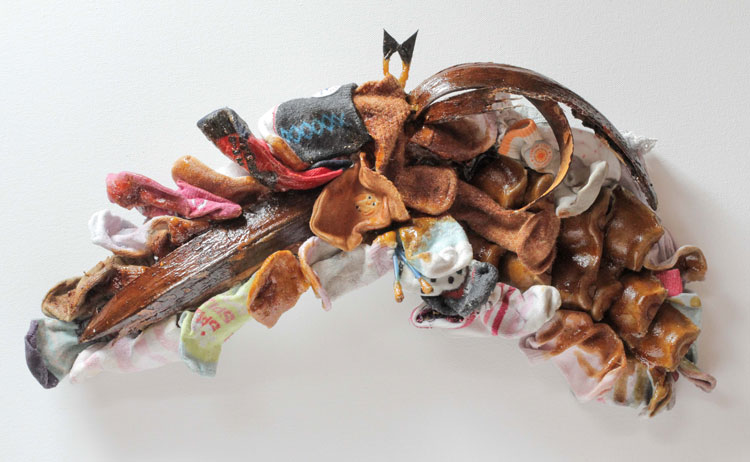
Lana Locke. Pangolin-Bat, 2020. Mixed media relief, 26 x 47 x 9 cm. © Lana Locke.
I have made a series of sculptures using the worn-out clothes of my two young daughters, not wanting them to go to waste, so instead transforming them into something new. The Pangolin-Bat (2020), a relief sculpture, is a kind of icky smörgåsbord of domestic duties, from waxy cotton buds (microcrystalline sculpting wax and shellac rather than my daughters’ abundant ear wax) to a collection of unpaired baby socks that I eventually gave up on sorting. So, instead, the odd socks are incorporated here, shaped like the scales of the endangered pangolin – similarly out of place as they are attached to bat wings (crossing species like the coronavirus).
CS: The film records your time in Australia during 2019 and 2020, in the wake of the extensive bush fires there. You make connections between those fires and colonialism, especially UK migrations to Australia, of which your own family is part. You mention the weeds that have also started growing in the bush, pushing out native species. Can you tell me a little more about how these ideas came together, and how you brought them together in your film?
LL: The idea came about through filmed material I collected instinctively at the time, then later pieced together and edited with archive footage, to think through the connections myself. I was visiting Australia over the Christmas and new year period when the fires were still going in Victoria, but had died out in Queensland, where my parents live. The damage to forests near their home was visible from the roads, and I was intrigued to take a closer look, but also shocked to hear the degree to which the local and national government were reportedly in denial about the link to climate change.
These evident ecological repercussions, which are explained by the Aboriginal fire experts I incorporate, really put me in touch with the continuing violence of Australia’s colonial history. As I say in the film, having emigrated there aged 14 and then left at 17, I always found it odd that the white man lives there at all – thinking particularly of the shopping malls and townscapes that seem to be plonked on to the land in rural areas – but it was perhaps not until the recent fires that I really saw this as a violence in itself.
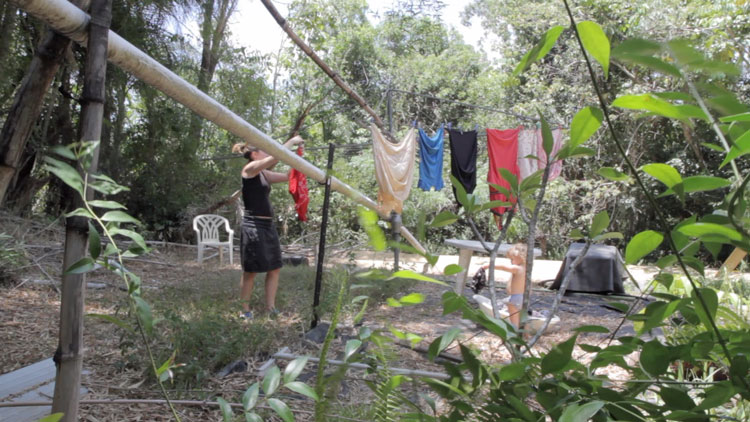
Lana Locke. Journeys of a Laundry Mountain, 2020 (video still). © Lana Locke.
Having begun filming myself hanging out the laundry in London, when I found myself doing the same in Australia, in my parents’ overgrown garden with makeshift water supply arrangements around it, this seemed a progression of the idea, as I am always trying to cut through restrictive ideas about domesticity being something very contained and normative. The washing line also seems like a semi-public statement of domestic ownership, a claiming of territory, which seems bizarre to me in these landscapes, and I like exploring the notion of being out of place. When researching my PhD on The Feral, the Art Object and the Social (2017) (at Chelsea College of Art and Design, University of the Arts London), I became particularly interested in the “feral” versus “native” plant species categorisations used by the anthropologist David Trigger in Australia. He uses the term feral to denote non-native, introduced plant species, as distinct from native, wild species.
CS: You also talk about the conflict between expediency in domestic work (the dryer, etc) and the environmental impact these technologies cause, capturing a sense of hopelessness in trying to balance these different needs. Did the process of making the film clarify your thoughts on these, and the struggle to live and work in an ethical way?
LL: The film crystallised some of the day-to-day difficulties I experience in trying to balance these various needs; seeking to reduce the expedient choices, but ultimately finding that I can’t resolve these issues on my own. In the film – and in life – I end up calling to the rest of the family to help me sort through the muddle. Perhaps the film then becomes a wider call for a collective thinking-through of these entangled issues.
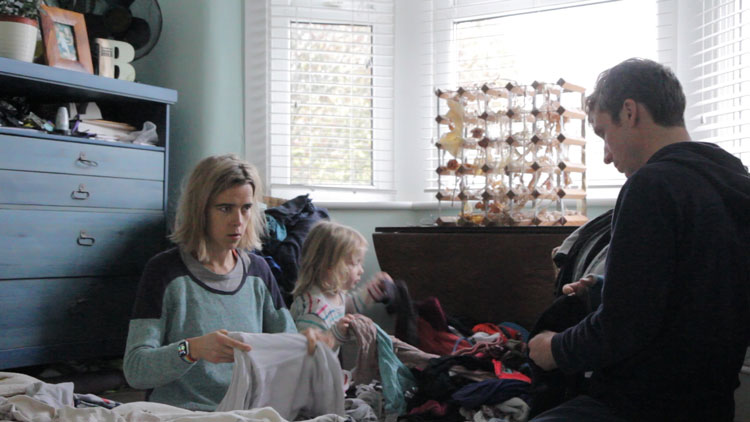
Lana Locke. Journeys of a Laundry Mountain, 2020 (video still). © Lana Locke.
I’m wary of middle-class bubbles where the focus on environmental consumer initiatives can distract from the need for more fundamental changes at governmental level; hence bringing in to the film some of the shocking, racist, archive British advertising that encouraged white Britons to go forth and multiply in Australia, “breeding a race second to none in the world” – without any thought as to the social or environmental impact on Australia. For me, the current feelings of helplessness come from where we are politically at the moment. Somehow, through ourselves, we need to force our countries’ leaders to help us all live more ethically more easily.
CS: In your film, the domestic acts of washing and cleaning things also tie into colonialism, as well as the current approaches and discourses to have emerged from the pandemic, which began during filming. I don’t know if you have read Purity and Danger (1966) by the anthropologist Mary Douglas, but in this book, she connects ideas about cleanliness and dirt to religious rituals, and how we order society accordingly. Has the pandemic, and our reactions to it, given you any further insight into how western societies conceptualise “dirt” and “cleanliness”, and the political and social implications?
LL: The pandemic has certainly complicated my own thinking around dirt and cleanliness. For sure, Douglas was somewhere in the mix in my original interest in the mountain of unsorted laundry, and how it sprawls out into the domestic space, with that definition of dirt she puts forward of “matter out of place”. I like how Douglas, and the philosophers Julia Kristeva, Georges Batailles, and new materialists such as Jane Bennett, give the abject this social value to mess with hierarchies. The anti-Chinese reaction when the pandemic first broke also put me in mind of contemporary writers such as Mel Y Chen and Rashad Shabazz, who explore how dirt and disease becomes racialised, but how these subjugating segregations have in the past (and it continues) forced minority groups into cramped living conditions where they are more likely to become sick.
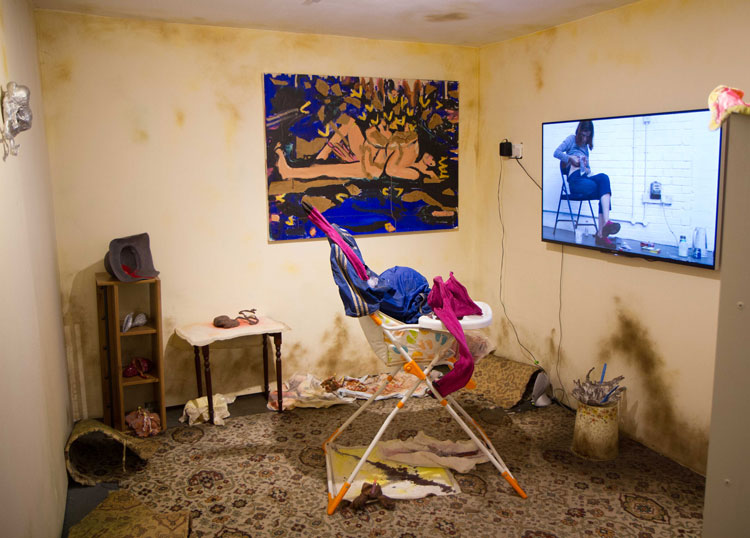
Lana Locke. Making (Babies), 2020. Installation, dimensions variable. Exhibition view, Lungley Gallery, London. © Lana Locke.
In early March last year, when I made my dirtied-down basement installation Making (Babies) (2020) at Lungley Gallery, I was seeking to reclaim the dirt as a disruptive agent to complicate the notion of domesticity being white, sanitised and heteronormative, and to evoke life that spills beyond these neat thresholds. But as the pandemic has progressed, it has felt harder to claim resistance to cleanliness as a radical position, even metaphorically, when quarantining, hand-washing and border controls became necessary to control the virus for the sake of the most vulnerable, and where research is continuing as to why some ethnic groups are disproportionately impacted.
So, in the film, I look more at the racial connotations of colour and whiteness in relation to the laundry rather than dirt itself. In times of drought, the rusty iron bore of my parent’s water supply stains the clothes as it cleans them, because the water level is so low. Not only does this prevent any whitening of the cloth, but there is a recurring staining, like the recurring wash cycles – making the drought visible and performable on our bodies, our clothing, our fingernails and toenails. It becomes a reminder of our reliance on the planet and the residue of earth that will continue to come back as part of our shared experience, globally. Similarly, while I was interested in the racialised implications of whiteness in commercial laundry advertisements, I channelled this into the sequence in the film around bleaching and the coronavirus, and the absurdity of a Trumpian politics that takes this bleaching towards an extreme, racist position.
CS: With these ideas in mind, what do you think are the greatest challenges for us, and what has your film, and thinking about these issues, highlighted for you about how we can change for the better?
LL: I think the greatest challenge, at a personal level, is overcoming the desire to forget the pandemic and the global social and environmental issues it throws up; forget it and return to how things were, without stopping to change or to protest strongly enough to force the government to change. In the film, I locate this desire in the boredom and frivolous games of my children, but I am as guilty of this desire as anyone. I long for all the things we can’t have during the restrictions, including things that are terrible for the environment, such as long-distance travel (even with the excuse of my family living in Australia). What was interesting about the beginning of the pandemic in terms of western attitudes was this idea that the virus was somewhere “over there”, as if our hierarchical ordering of things in terms of our own importance and privilege would somehow separate us from the virus, despite global travel, trade and manufacturing making us so interconnected with the rest of the planet, across nations, across species. Like the indigenous voices I incorporate in my film, my hope is that we can collectivise to look after this fragile ecology, to which we are all so intricately connected and indebted.
• Lana Locke’s short film Journeys of a Laundry Mountain (2020) is currently screening at Lungley Gallery, London, and will be shown as part of the Equality Video Club exhibition at National Kaohsiung Center for the Arts, Weiwuying, from 3-28 March 2021.
Lana Locke, Making (Babies), 2020. Video, 11 min 16 sec.